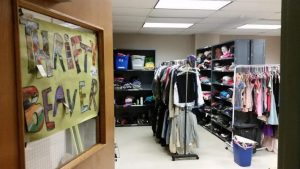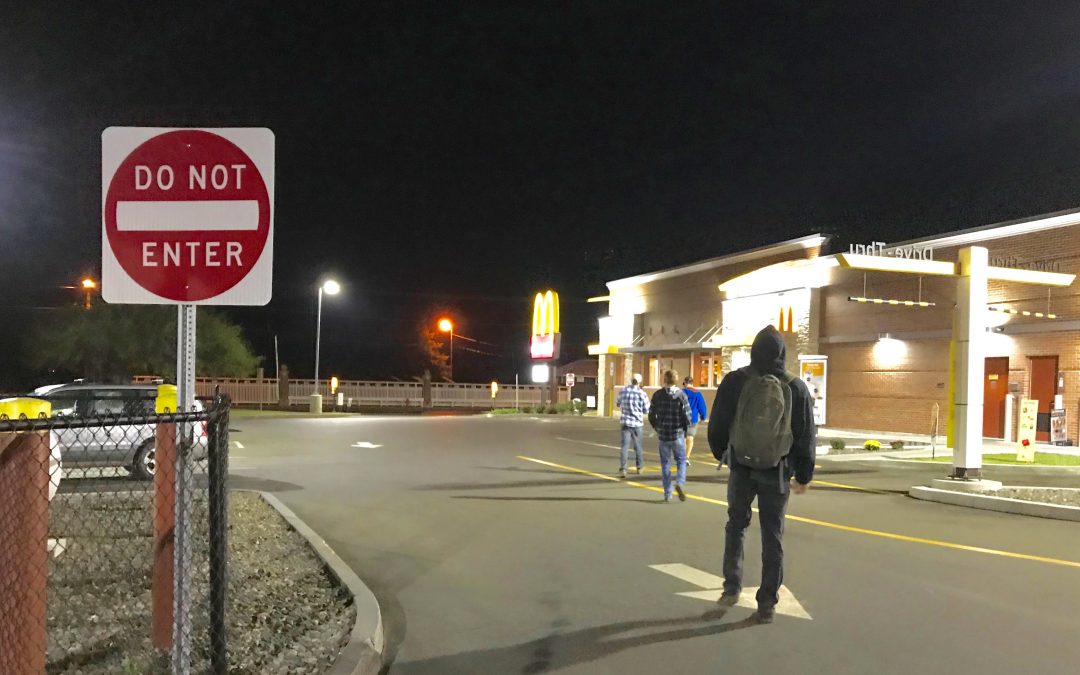Dec 9, 2017 | Exclusive |
Lindsay Mower – Staff Reporter
What makes Generation Z (Gen Z), those born in between 1996 and 2010, different from Millennials, those born between 1977 to 1995, are two major characteristics: they have never lived in a world without the internet (many of them haven’t experienced dial-up) and most of them can only recall September 11, 2001 as a historical event.
As a Gen X’er, born between 1965 and 1976, UMF’s Assistant Dean of Teaching Learning and Assessment Ashley Montgomery says there is an apparent generation gap between her and her Gen Z students, which is brought to light in the classroom.
Montgomery teaches a first-year seminar every fall that examines the anthropological repercussions of technology in the modern world called ‘The Internet of Us’ where, ironically, the discussion revolves around how technology impacts our interactions with each other by altering conversation and social engagement.
“My Generation Z students have grown up with devices in their life, that I did not grow up with, and those devices are such a significant part of how they interact with the world from a very early age,” said Montgomery.
She points out that one of the biggest challenges that she recognizes her Gen Z students facing is struggling with having to make face-to-face interactions with adults. “They aren’t as practiced with thinking out loud. It feels like we have to do a lot of translation,” she Montgomery. She believes this is because the Gen Z population may lack certain processing skills, most likely caused by the impacts technology has had on their childhood development.
Montgomery believes the Gen Z population may not quite see in themselves technology’s dangerous impact on our behavior in conversation, but they do see it in their parents. “They have this dynamic where they think, ‘I need to talk to my mom about something, but she’s on her phone. She says she’s listening to me, but I don’t think she is.’ And maybe the reason they think that is because they know in themselves that if they’re looking at their phone,” says Montgomery. “They aren’t really hearing everything you’re saying. They are giving you distracted attention.”
Another struggle Montgomery says she sees Gen Z students facing is making the adjustment to adulthood. “For many of them the shift of college, the shift away, where they have to create their own structure can be hard for them… It’s something I have seen increasing, she said. “I teach first semester, first year students… They have grown up in a more structured environment, from the outside, from parents and school and after school activities, and they have a lot of expectations, and then suddenly their structure isn’t being artificially imposed from somebody outside of themselves, and that’s a big hurdle for some of these students.”
Senior Outdoor Recreation and Business major Vaughn Keenhold, who has grown up in the Gen Z timeframe, agrees with Montgomery, but naturally sees the whole picture from a slightly different perspective. “I’ve was fortunate to grow up in a time when I didn’t have a cell phone, I didn’t have cable and I didn’t have internet in my house. My parents would bring us to family get togethers and I was always able to talk with adults and hold legitimate conversations with anyone from a young age,” says Keenhold, “however, I can totally see with those around me they while they are engaged in their phones, everything is happening around them, and they are having a harder time engaging with adults because of this.”
Keenhold, a Millennial, also doesn’t believe technology’s effects on social behavior are only affecting the Gen Z population. “I also think that adults now, with social media usage and everything like that, adults are having issues relating to other adults, as well as children, because of the same technology,” says Keenhold. “With Millennials and Generation Z, they just aren’t making the connections and experiences that they would normally be making otherwise, I don’t think it has as much to do with disruption of normal child development.”
Feeling uncomfortable with a lot of the ways that Millennials have been “pigeon-holed” or the way that tern has become a stereotype in the media, Montgomery finds herself waiting to see if Gen Z will be portrayed with a more positive manner. She believes that understanding each other and the differences in place due to these generational differences can help us to learn from each other. “We can use this generation gap as a lense to relate to each other in order to help better navigate the world,” said Montgomery.

Dec 8, 2017 | Exclusive |
By Leah Boucher –Staff Reporter
The UMF Track Club has recently grown to over 30 athletes, creating a challenge for its Executive Board to strictly adhere to the $4,200 budget given for the winter semester. With the first meet of the season on December 9th, the team faces the stress of funding before they begin to compete.
Instead of coaches taking on the responsibility of the club, students on the E-board are in control of finding transportation, lodging, and calculating the costs of each meet while trying to stay under budget. Ben Toribio, President of the club, knows that the increase in team size this semester will force them to make some changes in order to stay within their funds.

Senior Jesse Enos and UMF Alum Sean Cabaniss compete in an indoor track meet in 2016.
credit: Jesse Enos
“During the last indoor track season, we had around 20 athletes, allowing us to take school vans or local buses to meets,” said Toribio. “However, now that we are pushing 30 members, we need to look for other ways to transport the entire team without spending thousands of dollars on a coach bus.”
Jesse Enos, Vice President of the club, has the job of finding out what, how, and when the team will spend the money, forcing him and Toribio to make the decision to cancel the original first meet on December 2nd.
“To my knowledge, I don’t think the budget has changed drastically since last year, but more members means more equipment, gear, and entrance fees,” said Enos. “Plus, after looking for a coach bus to Smith College for two days, it would have put us out of $3,500, which made it fiscally irresponsible to attend that meet with our budget in mind.”
Kirsten Corey, Secretary of the Track Club, is sticking with a positive outlook on the season due to team growth. “When looking at our overall team goals for the winter semester, I do not expect that our limited budget will interfere with reaching them, as more members give us a stronger team,” said Corey. “Ultimately, our goals for indoor are to train and prepare for the NAC championship meet in the outdoor season, so even if we have a meet or two canceled, we can still prepare just as hard in practices.”
Enos believes that if the indoor club was instead a varsity sport, they may have more money to work with to attend meets in Massachusetts and other states in New England.
“Right now, it’s disappointing that we can’t attend more meets in various states, as this gives us more competition to work with and build from,” he said. “If we were a varsity sport, our funding would come from tuition, but as a club, most of our money comes from the activity fee that all students pay as well as any fundraising we take on, limiting our choice in meets in connection with their distance from UMF.”
Although the team will compete in Maine for the majority of their meets, Corey doesn’t want this to discourage new members. “Most of our new athletes are freshman, and they have a lot of potential and put a lot of work into each practice,” she said. “As a team, we need to support them and stress the importance of their talents and efforts.”

Nov 18, 2017 | Exclusive |
Lindsay Mower – Staff Reporter
Students in the Farmington Outing Club (FOC) are keeping happy this fall by staying outdoors as much as possible.

East Wilton native and Farmington Outing Club member Casey Taylor. (Photo by Maine Mountain Media)
East Wilton native and FOC member Casey Taylor, who has mostly been spending his Fall skateboarding in preparation for ski season, is very familiar with the outdoor activities available in Franklin County during this season. “Growing up here I had a really nature-based upbringing, by default. You’re taught to respect nature and to get outside and enjoy it with your friends,” said Taylor.
According to Taylor, FOC makes it easy to connect with others and get outside. “To find a group of people who are also interested in spending their time in nature is a beautiful thing,” said Taylor, “It’s just nice to be around people who do the things you do.”
UMF Outdoor Business Recreation Administration (ORBA) major and president of FOC Drew Bates says that UMF’s outing club is one of the main reasons why he fell in love with this area. “All my best friends were made at FOC,” said Bates. “Joining the club changed my life.”

Farmington Outing Club President Drew Bates whitewater kayaking. (Photo Courtesy of Drew Bates)
Bates says he has spent his fall outdoors biking on the trails at Titcomb in order to keep in shape while he also awaits the upcoming ski season. “Titcomb is where it’s at. They have some killer bike trails, which a lot of people don’t know, and it’s right down the road from campus which is cool too.”Also a member of FOC, Junior Biology major Jordan Kapiloff considers herself fortunate to be enrolled in the Entomology course offered at UMF, taught by Biology Professor Ronald Butler, where she gets to spend time outside doing field work and examining bugs.
Kapiloff, who admits she would much rather be outside than in a classroom, says taking this course has made her lab work much more enjoyable, and that she even gets outside to examine and collect bugs as a hobby when she’s not working on her class work.
“A bunch of my other friends have all been out collecting with me,” says Kapiloff, “We’ll go run around with our bug nets, and collect flowers and look at ants. It’s super fun and you get to be outside staying active, which is really cool.”

Jordan Kapiloff whitewater rafting with Conor Doherty. (Photo courtesy of Jordan Kapiloff)
Kapiloff also grew up in the Farmington area and attended Mount Blue High School, which, like Taylor says, naturally immersed her into the outdoorsy culture in the community.
“The Sandy River and Prescott Field are some of my favorite spots,” said Kapiloff. “I go down there with my friends almost every week, which is funny, because some students don’t even know the Sandy exists.”
Kapiloff expresses the reasoning behind her passion for the outdoors by explaining the meaning behind her bee tattoo. “These little things are absolutely vital to the way we live our life, and I find that so interesting,” said Kapiloff. “They are going extinct in certain places and I think that it’s so important to save the things that are small, and that may not seem that important, but that are actually very significant to the environment.”
Kapiloff says that getting involved with nature in a way that allows her to become a part of it, like she does in her Entomology course, is what keeps her happy and healthy. “I think that this class has helped to keep me in touch with nature and my surroundings this semester. It’s something that puts you outside of yourself and into the environment.”
Grace McNally, FOC member and senior Community Health Major, has been spending her Fall in the outdoors by working as an employee for Mainely Outdoors, the Fitness and Recreation Center’s outdoor excursion facility located on 144 Quebec Street in Farmington.

Mainely Outdoors guide Grace McNally enjoys the view. (Photo Courtesy of Grace McNailly)
“Over the summer I was working as an employee up at Grand Falls Hut for the Maine Huts and Trails non-profit organization. I learned so much about the outdoors and wildlife in Maine,” said McNally. “I wanted to stay outside as much as I could when classes started back up… I ended up getting hired by Mainely Outdoors, which has been the perfect opportunity for me.”
This past weekend McNally helped lead a six mile hike up to Stratton Brook Hut with a group of students, professors and community members. “It was a blast and everyone left happy and exhausted,” said McNally.
Naturally, Bates, Taylor, Kapiloff and McNally all plan on spending their winters outdoors as well. All alpine skiers, they hope to spend as much of their time as possible at Sugarloaf, and even may take a FOC trip up to the mountain in Carrabassett Valley.
Kapiloff advises anyone who has considered getting active outside and want to gain some experience in different areas of outdoor activities to come to a FOC meeting, which take place Thursday nights at 8pm in Thomas Auditorium.
“At the meeting you can get to meet people and learn about different things like skiing, snowboarding, biking, whitewater rafting, hiking, paddling and so on… Once you find your people and figure out what you like to do, you can just kind of branch out from there. It’s like a tree that you can just keep climbing.”
To stay involved with FOC and its members you can find them on Facebook and Instagram.

Nov 18, 2017 | Exclusive |
By Leah Boucher – Staff Reporter
UMF’s Thrifty Beaver Cooperative has recently completed changes in the location and services they offer in an effort to help hungry students and those who need new clothing for the winter.

The Thrify Beaver Co-op is now located in the basement of the Fusion Center. (Photo Courtesy of Danica Lamontagne)
Now located in the basement of the new Fusion Center building, students can receive any food in the food pantry for free and can participate in a clothing swap, where the number of clothes they bring in to donate is the number of clothes they can take from the store in return.
Originally developed by the UMF Sustainable Campus Coalition (SCC), Thrifty Beaver expanded in the past year from a simple thrift store on the third floor of Merrill to a thrift store and food pantry in a more central campus location near the Olsen Student Center. Luke Kellett, UMF Sustainability Coordinator and Assistant Professor of Anthropology, hopes that this change will allow students to feel more comfortable if they are in need of food or clothes.
“We intentionally combined the food pantry with the campus thrift store to reduce the stigma of accessing a food pantry,” said Kellett. “We are now one of over 400 university/college food pantries in the US, so this is a rapidly growing trend which shows that higher education is taking food insecurity and hunger seriously, an issue which has generally seen very little attention up until the last few years.”
As this semester winds down and students run out of meals on campus, this co-op hopes to provide frozen meals for students in need with a new refrigerator/freezer they received due to a grant.
“Foods like frozen burritos, pizza pockets, and so on will be available for students to eat right away or store in their own refrigerators in their rooms or off campus,” said Kellett. “Not only will the food pantry have an increase of meals for the cold season, but Thrifty Beaver also sees an increase in the amount of clothes donated right before and during the winter months.”
Danica Lamontagne, a senior double majoring in Environmental Policy and Planning and Political Science, is a Thrifty Beaver student worker who is aware of the rising issue of student hunger and need for warm clothes. “It’s sometimes hard for students to access local food pantries or clothing swaps, and they might feel ashamed visiting one of those facilities,” said Lamontagne. “Thrifty Beaver tries to normalize itself as a comfortable, local resource to be a part of; student hunger and students with lack of appropriate winter clothing is a serious issue not only on campus but in this country.”
Kelly Toomey, a junior Secondary Education and Environmental Science major and student leader of the SCC, is trying to publicize the services offered within Thrifty Beaver and increase student interest.
“At the beginning of November, we partnered with Johnson Scholars. They handed out cookies in the student center with a free coupon to Thrifty Beaver, a map of how to get there, and a chance to enter a raffle to win a Narrow Gauge Cinemas movie pass or a Hannaford gift card,” said Toomey. “We also have new signs in the front and back of the Fusion Center and maintain a website and Facebook page for those who want to know more about what we offer.”
Kellett believes that there will be more student interest and involvement, as foot traffic will increase when the Fusion Center is finally completed. However, he knows time is needed for any type of major increase in the number of student visitors.
“I have talked to other universities who have food pantries, thrift stores, or similar co-ops such as Thrifty Beaver. They have all informed me that it takes time for new services to be accessed,” he said. “That means we need to be patient yet engaged in keeping the co-op visible and active on campus.”
The Thrifty Beaver Co-op is located in room 004 in the basement of the Fusion Center and is open Sunday, Monday, and Thursday from 3-8.
Oct 27, 2017 | Exclusive |
By Alicia Davis – Contributing Writer
On a sunny Sunday afternoon, the UMF softball team had a game against alumni at the softball field. UMF softball beat the alumni team 3-2.
Coach Kat McKay, who will be entering her second year as the softball coach at UMF, felt that the game went well. “For the first year in many years without an alumni game, this
year was fantastic. I believe [the alumni] had an absolute blast,” said McKay. “They showed they still have all the skills to get the job done.”
Kailyn Hill, a junior at UMF and member of the softball team for the past two years, felt that the alumni game was very competitive. “We had a lot of fun. We had a back and forth game, so it was very competitive,” said Hill. “I pitched the first three innings, and then I played first base after.” This upcoming spring will be her third year playing softball for Farmington.
Alison Hamilton, a UMF alum, returned to play for the alumni team. She reclaimed her spot
in right field, where she played all four years during her time on the team at UMF. Hamilton’s favorite part about the game was getting to see her friends she met from softball.
“It was nice to see some former beavs, and reminisce about our time at UMF,” said Hamilton.
Eight alumni showed up to play in the game. “Because the alumni were down a player, the
UMF softball team leant us a player until Coach Pratt came in during the 5th inning to play for us,” said Hamilton.
The game was close to being tied in the end. The alumni and the UMF softball team felt both teams played well. “Our skills were equally matched,” said Hamilton. “We kept scoring back to back until we finally pulled through near the end of the game.”
McKay is looking forward to the spring season. “ I’m truly excited about this spring. We lost a handful of good athletes from our roster last year, but were able to replace and refocus with a large freshman class.”
Alyssa Dillan, a sophomore at UMF who will be playing her second year for the softball team this spring, is looking forward to what the season will bring for the team.
“I have high hopes for the spring season,” said Dillan. “I think that we have a lot of potential right now and I trust coach McKay will help us reach that potential.”
“We are selling pies to support our team to go to Florida in the spring,” said Hill. The softball team has an annual trip during the March spring break to Florida, where they will practice against other teams in preparation for the upcoming season.
People can support the UMF softball team by purchasing pies for their fundraiser. If anyone wants to purchase a pie, they can contact Coach Kat McKay for more details.

Oct 13, 2017 | Exclusive |
Lindsay Mower – Staff Reporter
In effort to increase health promotion, some towns have adopted drive-thru bans for fast food establishments. In some communities this type of ban has been around as far back as 1982: like San Luis Obispo, a college town located on the central coast of California.
With a population of 47,526, as compared to Farmington’s population of 7,760, San Luis Obispo is characterized by small shops, happy pedestrians and open sidewalks. The community originally adopted the ban in effort to maintain air quality, preserve the town’s character, promote a more pedestrian-oriented community and to reduce the high volume of traffic. A year later, neighboring City of Pismo Beach also banned drive-thrus within their Coastal Zone, followed by Arroyo Grande in 1991 and the City of Paso Robles in 2004.
“A student group galvanized citizens to push through a project that created a cultural and social focus for this city and, in doing so, improved the quality of its government. With more citizen participation, the town’s focus shifted away from optimizing the business environment to maximizing quality of life,” says an excerpt from ‘Thrive: Finding Happiness The Blue Zones Way’ by Dan Buettner, ‘In Lessons From San Luis Obispo’ published on BlueZones.com.
San Luis Obispo can’t keep a McDonald’s establishment in business. How can a college town in California with nearly five times the population of our own college town in Maine be unable to support a single McDonald’s, albeit one lacking a drive-thru, while we successfully support a Burger King, Taco-Bell, KFC and Dunkin Donuts, in addition to a McDonalds, and have various local restaurants in town that offer delivery and take-out options? While San Luis Obispo is a pedestrian-oriented community, Farmington’s drive-thru district is not. The bulk of our drive-thrus are located only in driving distance, making them a common option for busy people passing through who are most likely short on time to prepare a meal for themselves.
With Franklin County being one of the more unhealthy counties in Maine, at first glance it would seem like an obvious solution for Farmington to adopt a ban like this in effort to promote healthy lifestyles among the population.
Community Health Professor Maurice Martin admits he has never considered the implications of a removing the drive-thrus at fast food establishment in the name of health promotion. “I think if Farmington were to adopt the ban there would certainly be a boom to the area small businesses, which when the area small businesses are doing well, the general community health improves: on all levels, not just physical. If this were the case, that would be a huge benefit,” said Martin. “As far as whether or not people would curb their eating of fast foods, yeah, I think so… I can say for myself, if I want fast food it’s the drive-thru. I never go inside, because the idea of fast food is, ‘I’m hungry, right now.’”
Drive-thru ordinances may be inconvenient, especially to communities like Farmington, although their effect on overall population health has quite the silver lining. According to Buettner, as a result of the of the ordinance in San Luis Obispo they “gained a more aesthetically pleasing downtown, with less traffic, less pollution, more gathering places, projected green spaces, a farmer’s market, thriving arts, and an environment where it’s harder to do things that are bad for you (smoke, eat fast food) and easier to do things that are good for you (walk, eat vegetables, recreate in nature, and bike). The result is arguably the healthiest and happiest city in America.” San Luis Obispo has also adopted an Anti-smoking Policy.
Anthony Lewis, UMF English Major with a concentration in Music and Writing, doesn’t see drive-thru bans turning out as successfully in Farmington.“I don’t know if it would solve the problem here, it might help to alleviate the issue at hand, but I don’t even think it will happen,” says Lewis. “The government moves very slowly, everybody loves a good drive-thru and companies like McDonald’s make tons of money on them, so they will never want to give them up.”
The manager at the Farmington McDonald’s establishment was contacted but declined to be interviewed by the Farmington Flyer.
Martin suggests that, for health purposes, it may be a good idea for Farmington to put into effect a moratorium on drive-thrus, meaning no more can be added to the community than what already exist. “I don’t think that you are going to see the fast food establishments agree to a ban, nor do I think that the general population would agree that they should eliminate drive-thrus. Even though I would agree, they are here, and to roll back the clock is difficult.”






